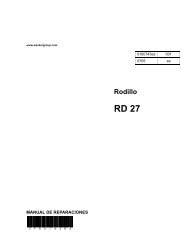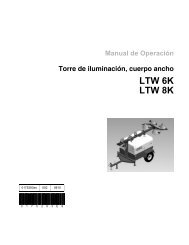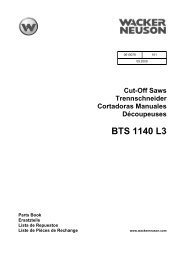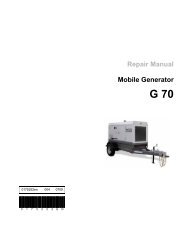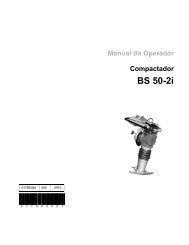LTC Repair Lombardini Engine Troubleshooting - Wacker Neuson
LTC Repair Lombardini Engine Troubleshooting - Wacker Neuson
LTC Repair Lombardini Engine Troubleshooting - Wacker Neuson
You also want an ePaper? Increase the reach of your titles
YUMPU automatically turns print PDFs into web optimized ePapers that Google loves.
<strong>LTC</strong> <strong>Repair</strong> Electrical <strong>Troubleshooting</strong><br />
6.2 Checking Continuity<br />
Conduct continuity tests when the engine is shut down.<br />
When checking continuity, use the Ohm setting on your multimeter.<br />
Place a lead of the multimeter on one end of the wiring or component<br />
and the other lead on the opposite end. If your meter reads “OL” or<br />
“OPEN”, there is no continuity and the wiring or component must be<br />
repaired or replaced.<br />
Note: Some multimeters also have an audio signal setting for<br />
determining continuity. This setting may also be used.<br />
If your meter reads less than 1.0 Ohm, or the audio signal<br />
sounds, the wiring or component has continuity and should be<br />
OK.<br />
If your meter reads more than 1.0 Ohm, the wiring is faulty and<br />
must be repaired or replaced.<br />
6.3 Checking resistance<br />
6.4 Checking voltage<br />
Conduct resistance checks when the engine is shut down.<br />
Use the Ohm setting on your multimeter.<br />
Conduct resistance checks when the machine is as close to 21°C<br />
(70°F) as possible. Higher temperatures can affect resistance values.<br />
Most digital multimeters have some internal resistance. To obtain your<br />
multimeter’s internal resistance, simply cross the two leads of your<br />
multimeter and read the display. When conducting a resistance check,<br />
subtract your multimeter’s internal resistance from the value you<br />
measure to obtain the true resistance of the component you are<br />
checking.<br />
Conduct voltage checks when the engine is running.<br />
Use the Volt setting on your multimeter. To prevent damage to your<br />
instrument, start with the highest scale available on your multimeter.<br />
Adjust to a lower scale as readings dictate.<br />
Use extreme caution when checking voltage to reduce the risk of<br />
electric shock.<br />
73






